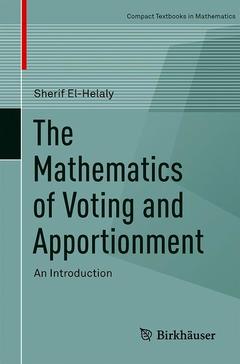Description
The Mathematics of Voting and Apportionment, 1st ed. 2019
An Introduction
Compact Textbooks in Mathematics Series
Author: El-Helaly Sherif
Language: English
Subject for The Mathematics of Voting and Apportionment:
Publication date: 06-2019
264 p. · 15.5x23.5 cm · Paperback
264 p. · 15.5x23.5 cm · Paperback
Description
/li>Contents
/li>Biography
/li>Comment
/li>
This textbook contains a rigorous exposition of the mathematical foundations of two of the most important topics in politics and economics: voting and apportionment, at the level of upper undergraduate and beginning graduate students. It stands out among comparable books by providing, in one volume, an extensive and mathematically rigorous treatment of these two topics.
The text?s three chapters cover social choice, yes-no voting, and apportionment, respectively, and can be covered in any order, allowing teachers ample flexibility. Each chapter begins with an elementary introduction and several examples to motivate the concepts and to gradually lead to more advanced material. Landmark theorems are presented with detailed and streamlined proofs; those requiring more complex proofs, such as Arrow?s theorems on dictatorship, Gibbard?s theorem on oligarchy, and Gärdenfors? theorem on manipulation, are broken down into propositions and lemmas in order to make them easier to grasp. Simple and intuitive notations are emphasized over non-standard, overly complicated symbols. Additionally, each chapter ends with exercises that vary from computational to ?prove or disprove? types.
The Mathematics of Voting and Apportionment will be particularly well-suited for a course in the mathematics of voting and apportionment for upper-level undergraduate and beginning graduate students in economics, political science, or philosophy, or for an elective course for math majors. In addition, this book will be a suitable read for to any curious mathematician looking for an exposition to these unpublicized mathematical applications.
No political science prerequisites are needed. Mathematical prerequisites (included in the book) are minimal: elementary concepts in combinatorics, graph theory, order relations, and the harmonic and geometric means. What is needed most is the level of maturity that enables the student to think logically, derive results from axioms and hypotheses, and intuitively grasp logical notions such as ?contrapositive? and ?counterexample.?
Chapter 1: Social Choice.- Introduction.- Elimination Procedures.- Condorcet Ideas and Related Procedures.- Scoring Procedures: Borda Count.- A Glimpse into Social Welfare Theory.- Social Choice Procedures: Indifference and Ties Allowed.- Manipulability of Social Choice Procedures: Indifference and Ties Allowed.- Exercises.- Chapter 2: Yes-No Voting.- Introduction.- Quantification of Power in a Yes-No Voting System.- Some Combinatorics.- Banzhaf and Shapley-Shubik Indices in One View.- Weightable Yes-No Voting Systems.- Exercises.- Chapter 3: Apportionment.- Introduction.- Axioms of Apportionment.- Quota Procedures.- Divisor Procedures.- Equity Criteria.- Apportionment Paradoxes.- Applications of Priority Formulas.- Exercises.
Sherif El-Helaly is an associate professor at The Catholic University of America in Washington, DC, where he has been teaching a course on mathematical topics in the social sciences for twenty years.
Provides students with an accessible overview of the mathematical concepts central to voting systems
Allows readers to engage with the material in a variety of ways, with chapters that can be approached in any order
Includes a chapter on the mathematics of apportionment, a topic not always covered in adequate detail
© 2024 LAVOISIER S.A.S.




